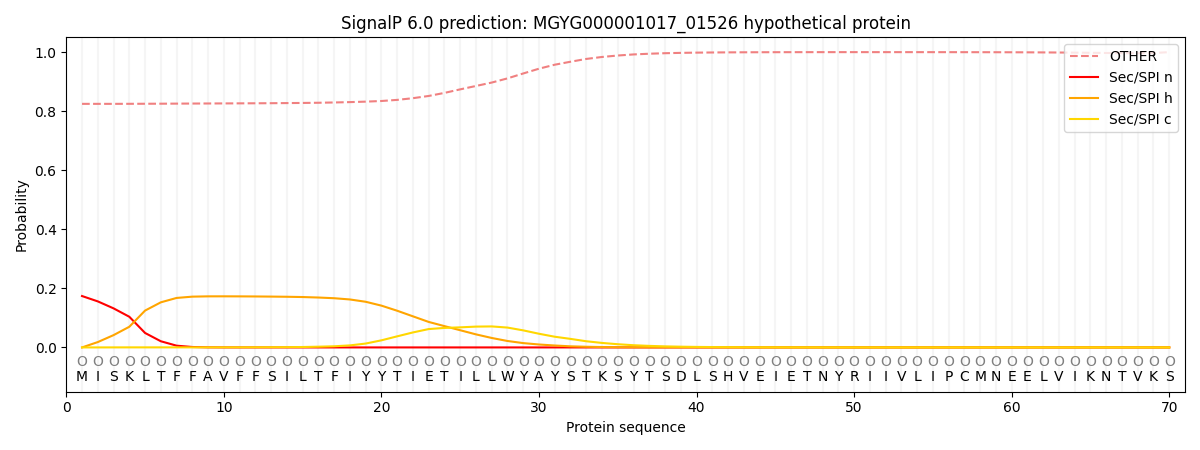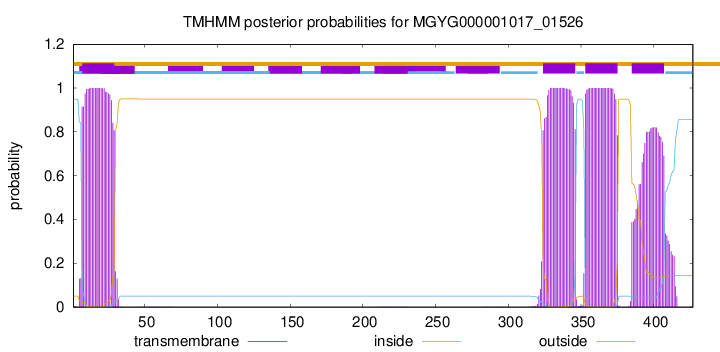You are browsing environment: HUMAN GUT
CAZyme Information: MGYG000001017_01526
You are here: Home > Sequence: MGYG000001017_01526
Basic Information |
Genomic context |
Full Sequence |
Enzyme annotations |
CAZy signature domains |
CDD domains |
CAZyme hits |
PDB hits |
Swiss-Prot hits |
SignalP and Lipop annotations |
TMHMM annotations
Basic Information help
| Species | Lactococcus garvieae_B | |||||||||||
|---|---|---|---|---|---|---|---|---|---|---|---|---|
| Lineage | Bacteria; Firmicutes; Bacilli; Lactobacillales; Streptococcaceae; Lactococcus; Lactococcus garvieae_B | |||||||||||
| CAZyme ID | MGYG000001017_01526 | |||||||||||
| CAZy Family | GT2 | |||||||||||
| CAZyme Description | hypothetical protein | |||||||||||
| CAZyme Property |
|
|||||||||||
| Genome Property |
|
|||||||||||
| Gene Location | Start: 12; End: 1295 Strand: + | |||||||||||
CAZyme Signature Domains help
| Family | Start | End | Evalue | family coverage |
|---|---|---|---|---|
| GT2 | 53 | 169 | 9.4e-20 | 0.611764705882353 |
| GT2 | 146 | 366 | 3.8e-16 | 0.9796954314720813 |
CDD Domains download full data without filtering help
| Cdd ID | Domain | E-Value | qStart | qEnd | sStart | sEnd | Domain Description |
|---|---|---|---|---|---|---|---|
| cd06436 | GlcNAc-1-P_transferase | 4.74e-67 | 53 | 241 | 1 | 191 | N-acetyl-glucosamine transferase is involved in the synthesis of Poly-beta-1,6-N-acetyl-D-glucosamine. N-acetyl-glucosamine transferase is responsible for the synthesis of bacteria Poly-beta-1,6-N-acetyl-D-glucosamine (PGA). Poly-beta-1,6-N-acetyl-D-glucosamine is a homopolymer that serves as an adhesion for the maintenance of biofilm structural stability in diverse eubacteria. N-acetyl-glucosamine transferase is the product of gene pgaC. Genetic analysis indicated that all four genes of the pgaABCD locus were required for the PGA production, pgaC being a glycosyltransferase. |
| cd06423 | CESA_like | 1.28e-27 | 53 | 241 | 1 | 180 | CESA_like is the cellulose synthase superfamily. The cellulose synthase (CESA) superfamily includes a wide variety of glycosyltransferase family 2 enzymes that share the common characteristic of catalyzing the elongation of polysaccharide chains. The members include cellulose synthase catalytic subunit, chitin synthase, glucan biosynthesis protein and other families of CESA-like proteins. Cellulose synthase catalyzes the polymerization reaction of cellulose, an aggregate of unbranched polymers of beta-1,4-linked glucose residues in plants, most algae, some bacteria and fungi, and even some animals. In bacteria, algae and lower eukaryotes, there is a second unrelated type of cellulose synthase (Type II), which produces acylated cellulose, a derivative of cellulose. Chitin synthase catalyzes the incorporation of GlcNAc from substrate UDP-GlcNAc into chitin, which is a linear homopolymer of beta-(1,4)-linked GlcNAc residues and Glucan Biosynthesis protein catalyzes the elongation of beta-1,2 polyglucose chains of Glucan. |
| COG1215 | BcsA | 2.31e-23 | 1 | 414 | 6 | 406 | Glycosyltransferase, catalytic subunit of cellulose synthase and poly-beta-1,6-N-acetylglucosamine synthase [Cell motility]. |
| cd06438 | EpsO_like | 3.66e-17 | 53 | 241 | 1 | 180 | EpsO protein participates in the methanolan synthesis. The Methylobacillus sp EpsO protein is predicted to participate in the methanolan synthesis. Methanolan is an exopolysaccharide (EPS), composed of glucose, mannose and galactose. A 21 genes cluster was predicted to participate in the methanolan synthesis. Gene disruption analysis revealed that EpsO is one of the glycosyltransferase enzymes involved in the synthesis of repeating sugar units onto the lipid carrier. |
| cd00761 | Glyco_tranf_GTA_type | 4.49e-15 | 53 | 167 | 1 | 102 | Glycosyltransferase family A (GT-A) includes diverse families of glycosyl transferases with a common GT-A type structural fold. Glycosyltransferases (GTs) are enzymes that synthesize oligosaccharides, polysaccharides, and glycoconjugates by transferring the sugar moiety from an activated nucleotide-sugar donor to an acceptor molecule, which may be a growing oligosaccharide, a lipid, or a protein. Based on the stereochemistry of the donor and acceptor molecules, GTs are classified as either retaining or inverting enzymes. To date, all GT structures adopt one of two possible folds, termed GT-A fold and GT-B fold. This hierarchy includes diverse families of glycosyl transferases with a common GT-A type structural fold, which has two tightly associated beta/alpha/beta domains that tend to form a continuous central sheet of at least eight beta-strands. The majority of the proteins in this superfamily are Glycosyltransferase family 2 (GT-2) proteins. But it also includes families GT-43, GT-6, GT-8, GT13 and GT-7; which are evolutionarily related to GT-2 and share structure similarities. |
CAZyme Hits help
| Hit ID | E-Value | Query Start | Query End | Hit Start | Hit End |
|---|---|---|---|---|---|
| BAV03148.1 | 1.47e-299 | 1 | 427 | 213 | 639 |
| QSR12063.1 | 3.13e-297 | 1 | 427 | 284 | 710 |
| QSQ99901.1 | 1.47e-295 | 1 | 427 | 284 | 710 |
| QEA35871.1 | 1.11e-229 | 1 | 426 | 271 | 696 |
| QEA54613.1 | 4.47e-229 | 1 | 426 | 271 | 696 |
Swiss-Prot Hits download full data without filtering help
| Hit ID | E-Value | Query Start | Query End | Hit Start | Hit End | Description |
|---|---|---|---|---|---|---|
| Q5HKQ0 | 1.12e-12 | 54 | 305 | 52 | 288 | Poly-beta-1,6-N-acetyl-D-glucosamine synthase OS=Staphylococcus epidermidis (strain ATCC 35984 / RP62A) OX=176279 GN=icaA PE=1 SV=1 |
| Q8GLC5 | 4.74e-12 | 54 | 305 | 52 | 288 | Poly-beta-1,6-N-acetyl-D-glucosamine synthase OS=Staphylococcus epidermidis OX=1282 GN=icaA PE=3 SV=1 |
| Q5HCN1 | 1.50e-11 | 8 | 304 | 6 | 287 | Poly-beta-1,6-N-acetyl-D-glucosamine synthase OS=Staphylococcus aureus (strain COL) OX=93062 GN=icaA PE=3 SV=1 |
| Q6GDD8 | 1.50e-11 | 8 | 304 | 6 | 287 | Poly-beta-1,6-N-acetyl-D-glucosamine synthase OS=Staphylococcus aureus (strain MRSA252) OX=282458 GN=icaA PE=3 SV=1 |
| Q7A351 | 1.50e-11 | 8 | 304 | 6 | 287 | Poly-beta-1,6-N-acetyl-D-glucosamine synthase OS=Staphylococcus aureus (strain N315) OX=158879 GN=icaA PE=3 SV=1 |
SignalP and Lipop Annotations help
This protein is predicted as OTHER

| Other | SP_Sec_SPI | LIPO_Sec_SPII | TAT_Tat_SPI | TATLIP_Sec_SPII | PILIN_Sec_SPIII |
|---|---|---|---|---|---|
| 0.834678 | 0.161663 | 0.000861 | 0.000602 | 0.000366 | 0.001845 |

